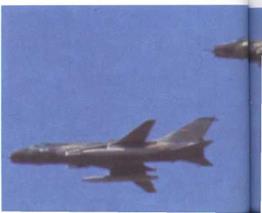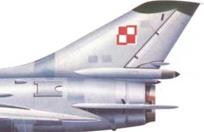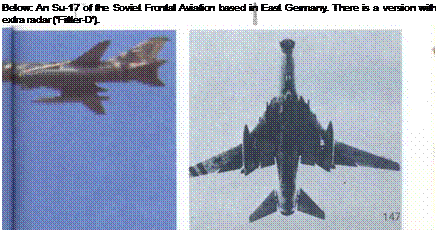Sukhoi Su-17 and Su-20
Su-17 "Fitter C", Su-20 and Su-22
Origin: The design bureau named for Pavel 0. Sukhoi. Soviet Union. Type: Single-seat attack and close-support aircraft.
Engine: (-17) one Lyulka AL-21 F-3 single-shaft turbojet with afterburner rated at 17,2001b (7800kg) dry and 25.0001b (11,340kg) with maximum afterburner. (-20. -22) believed to beAL-7F-1 rated at 22,046lb (10,000kg). Dimensions (all): Span (28“) 45ft 11Jin (14 00m), (62°) 34ft 9Jin (10-60m): length (incl probe) 61 ft 6Jin (18-75m); height 1 5ft 7in (4-75m). Weights: (-17 estimated. -20 and -22 slightly less) empty 22.046lb (10,000kg); loaded (clean) 30,865lb (14,000kg). (maximum) 41.8871b (19.000kg).
Performance: (-17, clean) maximum speed at sea level 798mph (1284 km/h. Mach 1 05). maximum speed at optimum height 1,432mph (2305 km/h. Mach 2-17); initial climb 45,275ft (13.800m)/min; service ceiling 59.050ft (18.000m); combat radius with 4,4101b (2000kg) external stores (hi-lo-hi) 391 miles (630km).
Armament: Two 30mm NR-30 cannon, each with 70 rounds, in wing roots; eight pylons under fuselage, fixed gloves and swing-wings for maximum external load of 11,0231b (5000kg) including the AS-7 "Kerry” air-to-surface missile ( 20, -22. six pylons).
History: First public display at Domodedovo 1967; service delivery, possibly 1970 (-17) and 1972-3 (-20).
Users: Egypt (-20). Peru ( 22). Poland (-20). Soviet Union (FA. -17).
 |
Development: A logical direct modification of the somewhat limited Su-7B, the Su-17 has variable-geometry "swing-wings" pivoted far outboard, hinged to a slightly modified -7B centre section with strengthened landing gear – At maximum sweep the trailing edge of the centre section aligns with the outer section, and it carries two shallow fences on each side. At the pivots are large square-fronted fences combined with pylons which are stressed to carry 2.200lb (1000kg) stores which in the Polish Su-20 are
 Right: Part of a substantial formation of Su-20 variable – geometry attack aircraft in service with the Egyptian Air Force. All versions normally fly with two large jettisonable tanks on the wing-pivot pylons. In the conflict with Libya a few aircraft of this type were in mutual conflict.
Right: Part of a substantial formation of Su-20 variable – geometry attack aircraft in service with the Egyptian Air Force. All versions normally fly with two large jettisonable tanks on the wing-pivot pylons. In the conflict with Libya a few aircraft of this type were in mutual conflict.
invariably drop tanks with nose fins. The swing-wings carry full-span slats, slotted ailerons and flaps which retract inside the centre section. Compared with the Su-7B the result is the ability to lift twice the external load from airstrips little more than half as long, and climb and level speed at all heights are much increased, even in the lower-powered Su-20 and export Su-22. Equipment in the -17 includes SRD-5M "High Fix" radar, an ASP-5ND fire-control system and comprehensive communications and IFF. Landing performance is so much better than the -7B that a braking chute is not fitted; in its place is the aft-facing aerial for a Sirena 3 radar homing and warning system at the rear of the prominent dorsal spine. Peru’s 36 aircraft were to be delivered in 1977.


Left: An Su-20 in service with the PWL (Polish Air Force). Despite various differences this type has the same NATO code of ‘Fitter-C’ as the Soviet Union’s Su-17.










